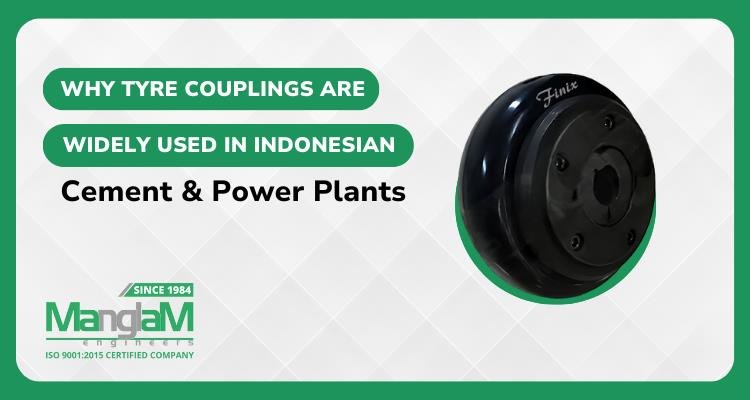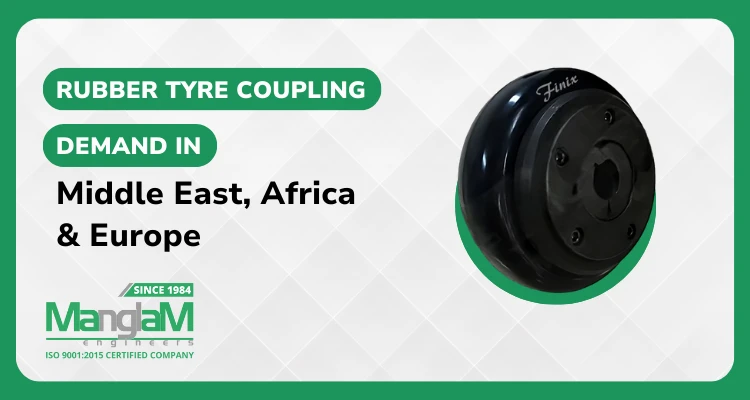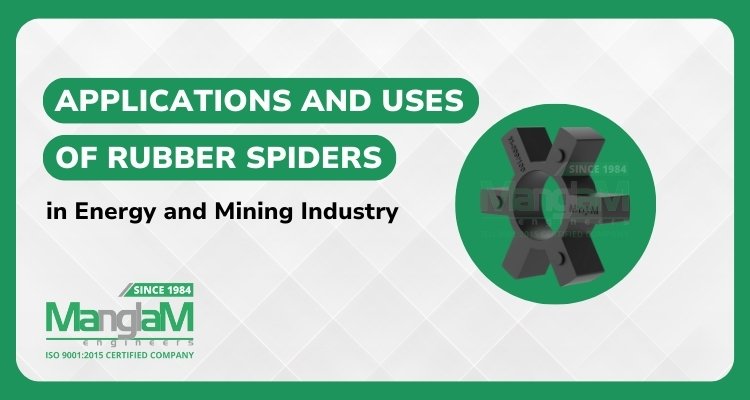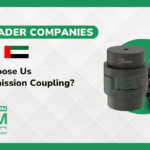
Why Trader Companies in UAE Should Choose Us for Transmission Coupling
July 28, 2025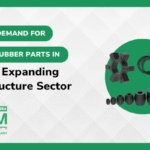
Growing Demand for Durable Rubber Parts in Africa’s Expanding Infrastructure Sector
August 15, 2025Introduction
Indonesia, one of Southeast Asia's largest cement and power plant hubs, faces growing energy and infrastructure needs. With industries running 24/7 in challenging conditions like heavy loads, heat, dust, and vibrations, durable machinery components are crucial for efficiency. Tyre couplings help minimize downtime by absorbing vibration, handling misalignment, and offering low maintenance in harsh environments.
For 40+ years, Manglam Engineers has been supplying reliable, high-quality Tyre couplings for Indonesian industries, providing custom solutions and ensuring consistent performance.
Powering Indonesia’s Cement & Power Plants with Tyre Couplings
1. Cement Industry
Indonesia’s cement production drives infrastructure and housing projects. Major players like Semen Indonesia and Indocement operate 24/7 plants to meet demand. These plants face tough conditions, such as high stress, dust, and vibrations, requiring durable components like Tyre couplings for reliable operation. Challenges include extreme weather and geological factors.
2. Power Industry:
The power sector is expanding rapidly to meet rising demand. Indonesia’s grid relies on a mix of coal, geothermal, and increasing renewables. With continuous operation under harsh conditions, power plants need equipment that can handle high temperatures, vibrations, and shock loads. Geographical challenges like humidity and remote locations also demand reliable, low-maintenance equipment.
What Are Tyre Couplings?
Tyre couplings are a type of flexible coupling designed to transmit torque between two shafts while compensating for misalignment, shock loads, and vibrations.
The construction and working principles of Tyre couplings make them ideal for cement and power plants, where heavy-duty machinery operates under extreme conditions.
Key Components:
- Flanges: Typically made of steel, these flanges connect the driving and driven shafts.
- Rubber Element: The rubber "Tyre" in the center of the coupling absorbs shocks and compensates for misalignments. The rubber is reinforced with fabric or steel for added strength.
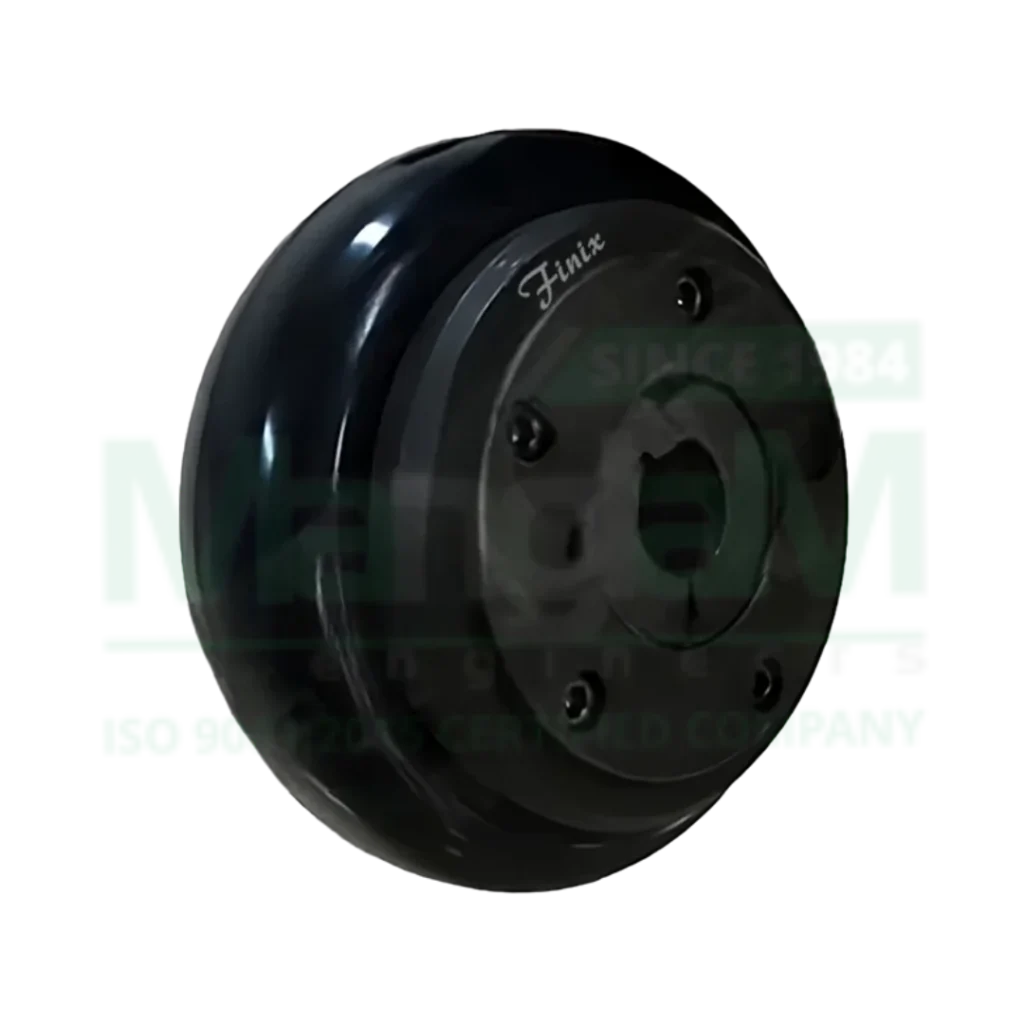
Working Principle:
Tyre couplings transmit torque through torsional shear within a flexible rubber element clamped between two hubs. As torque is applied, this element deforms, allowing it to absorb shock loads, accommodate significant shaft misalignments, and effectively dampen vibrations.
Performance Specifications:
- Angular Misalignment: Up to 4°
- Parallel Misalignment: Up to 6mm
- Axial Misalignment: Up to 8mm
- Torsional Flexibility: Up to 12° at maximum torque
These performance capabilities make Tyre couplings ideal for applications in cement and power plants, where misalignment and shock loads are common.
Features of Tyre Couplings
- No Maintenance Required: Once this coupling is installed, you don't need to worry about regular check-ups or service. You can just set it up and let it run without any further attention.
- Easy and Effortless Installation: Putting this coupling in place is a very simple and quick process. You don't need special tools or a lot of time, which makes the setup hassle-free.
- Lubrication Free: The rubber part can be replaced quickly without moving heavy machinery, reducing downtime significantly.
- Flexibility and Torsional Resilience: The coupling is very flexible, allowing it to bend and twist safely when machinery starts or stops suddenly.
- High Misalignment Capability: It functions effectively even if the two machine shafts are not perfectly aligned. The coupling's flexibility easily accommodates small offsets, whether angular or parallel.
- Vibration Dampening: The rubber in the coupling acts like a sponge for vibrations and shaking. It absorbs this movement, which leads to quieter operation and protects the machinery from damage.
Tyre Coupling Video
Challenges in Indonesian Cement & Power Plants:
Here’s a quick look at the challenges these industries face and how Tyre couplings help overcome them.
1. Continuous, Heavy-Duty Operations
- 24/7 machinery operation under high stress.
- Constant wear and tear on essential components.
2. Mechanical Misalignment
- Thermal expansion causes parts to shift.
- Foundation shifting over time leads to misalignment.
3. Vibration and Shock Loads
- Intense vibrations from rotating machinery (fans, compressors, crushers).
- Increased stress and wear on rigid components.
- Potential shortening of equipment lifespan without proper damping.
4. Harsh Environmental Conditions
- Exposure to high temperatures can weaken materials.
- Dusty and abrasive air can cause significant wear.
- Chemical exposure accelerates material degradation and reduces reliability.
In such conditions, only components that are flexible, durable, and resistant to wear can maintain performance and reduce unscheduled shutdowns.
Rubber element couplings like Tyre couplings offer resilience and flexibility to thrive under these exact challenges, making them a smart investment for both cement and power facilities in Indonesia.
How Do Tyre Couplings Solve Problems?
1. Flexible Performance Under Misalignment
Handles all types of misalignments (axial, radial, angular), reducing stress and wear on equipment.
2.Excellent Vibration & Shock Absorption
Rubber elements absorb shock and vibration, protecting heavy machinery like ball mills, turbines, and crushers.
3. Easy Maintenance
Quick rubber element replacement without shaft disassembly, minimizing downtime and maintenance costs.
4.Built for Harsh Environments
Withstands high heat, dusty conditions, and chemical exposure, making it ideal for kilns, cement crushers, and power plant pumps.
5.Energy Efficient
Smoothens operation by reducing vibration and accommodating misalignment, leading to better energy efficiency.
6. Cost-Effective
Long lifespan and reduced maintenance costs make Tyre couplings a smart investment.
These benefits make Tyre couplings an economical choice for large-scale industrial operations.
Where Are Tyre Couplings Used in Cement & Power Plants?
1. Cement Plants
In cement plants, where equipment like rotary kilns, grinding mills, and crushers operate under intense stress, Tyre couplings offer several advantages:
- Rotary Kilns: Tyre couplings handle thermal expansion and misalignments at high temperatures.
- Grinding Mills: Heavy shock loads and continuous operation place immense stress on grinding mills. Tyre couplings help absorb these shocks, ensuring longer service life for critical components.
- Conveyor Systems: Tyre couplings maintain smooth power transmission, even in dusty, corrosive environments.
- Crushers: Crushers in cement plants generate heavy vibrations. Tyre couplings dampen these vibrations, preventing damage to the connected machinery and ensuring smooth operation.
2. Power Plants
In power plants, Tyre couplings provide the necessary flexibility and shock absorption for equipment that operates under harsh conditions:
- Turbines and Generators: Tyre couplings are used to connect turbines and generators, where thermal cycling and vibrations can cause misalignment. They help absorb shocks and vibrations, reducing wear on the equipment.
- Cooling System Pumps: Power plants require reliable cooling systems. Tyre couplings help accommodate misalignments in pump drives, ensuring efficient operation.
- Auxiliary Equipment: From compressors to fans, Tyre couplings protect auxiliary equipment in power plants from thermal expansion and mechanical stress, enhancing overall plant reliability.
With a wide product portfolio, Manglam Engineers supplies industrial Tyre couplings and compatible rubber components tailored to each machinery type, ensuring reliable performance across sectors.
Comparative Analysis: Tyre Couplings vs Other Types of Couplings
1. Tyre vs Gear Couplings
- Advantages: Tyre couplings offer superior shock absorption, require less maintenance, and tolerate misalignment better.
- Trade-offs: Gear couplings handle higher torque but offer less flexibility and are more prone to wear.
2. Tyre vs Disc Couplings
- Advantages: Tyre couplings are more cost-effective, easier to maintain, and offer better shock absorption.
- Trade-offs: Disc couplings are more suitable for high-speed applications but are less effective at absorbing vibrations.
3. Tyre vs Grid Couplings
- Advantages: Tyre couplings require no lubrication and handle misalignment effectively.
- Trade-offs: Grid couplings provide higher torque density but are more prone to wear under frequent use.
| Feature | Tyre Couplings | Gear Couplings | Disc Couplings | Grid Couplings |
|---|---|---|---|---|
| Misalignment Capability | High (up to 6mm) | Moderate | Low | Moderate |
| Shock Absorption | Excellent | Moderate | Good | Fair |
| Torque Capacity | Moderate | High | Moderate | High |
| Lubrication Requirement | None | Required | None | Required |
| Maintenance | Low | Moderate | Low | High |
Step-by-Step Guide for Tyre Coupling Installation
Step 1: Preparation and Inspection
- Inspect Flanges: Check for any signs of wear, corrosion, or damage on the flanges. They should be clean and smooth to ensure proper alignment.
- Check the Shaft Alignment: The shafts should be properly aligned according to the manufacturer’s specifications. Misalignment can cause premature coupling failure.
Step 2: Mounting the Flanges
- Position the Flanges: Secure the flange on the driving shaft and the driven shaft using bolts. Ensure the bolts are evenly torqued to avoid any unbalanced loading.
- Torque Specifications: Follow the manufacturer’s torque specifications to avoid damaging the flanges or creating an imbalance.
Step 3: Installing the Rubber Tyre Element
- Place the Tyre: Position the rubber element (Tyre) in the space between the two flanges. Ensure the Tyre is seated evenly and there is no distortion or damage to the rubber.
- Alignment Check: Confirm that the rubber element is aligned properly with both flanges. The flanges should not touch the Tyre element, as this may cause excessive wear.
Step 4: Securing the Coupling
- Tighten Bolts: Once the rubber element is in place, tighten the bolts that secure the flanges to the shafts.
- Final Alignment Check: Perform a final check of the alignment to ensure that the coupling operates smoothly.
Step 5: Testing the Coupling
- Rotate the Shafts: Slowly rotate both shafts by hand to ensure that the coupling is functioning correctly. There should be no binding or unusual resistance.
- Run the Equipment: Start the equipment at low speeds and gradually increase the speed while monitoring the performance. Check for vibrations or irregular noises that could indicate improper installation.
Step 6: Post-Installation Checks
- Monitor for Heat and Vibration: After installation, monitor the coupling’s performance for heat build-up or vibrations. Excessive heat or vibrations could indicate misalignment or other issues.
- Routine Inspections: Schedule regular inspections to check for wear on the rubber element, especially in harsh environments like cement or power plants.
Get Best Plant Performance with Proper Coupling Care:
- Visual Inspections: Check for cracks, wear, or degradation in the rubber element.
- Timely Rubber Replacement: Replace worn rubber components before failure to avoid costly downtime.
- Bolt Tightness & Lubrication: Periodically check and retighten bolts. Apply anti-seize compound to prevent corrosion.
- Preventive Measures: To maintain your equipment properly, keep a record of its alignment, use sensors to monitor vibration levels over time, and always have spare coupling parts in stock.
Following these coupling alignment techniques and preventive care steps ensures longer life and fewer shutdowns in your plant.
Why Choose Manglam Engineers for Tyre Couplings in Indonesia?
Manglam Engineers stands out as a trusted provider of coupling solutions across Indonesia’s cement and power sectors.
What Sets Us Apart:
40+ Years of Expertise: Deep knowledge in designing, manufacturing, and supplying power transmission couplings.
Comprehensive Product Range: From Tyre couplings to Jaw, RRL, and rubber elements, we’ve got your needs covered.
Customization & Quality Assurance: Tailored solutions with rigorous quality checks.
Local Support: Fast delivery, expert advice, and on-ground technical support in Indonesia.
Focus on Uptime: Minimizes downtime and extends machinery life.
Outlook:
The future of Tyre couplings in Indonesia looks promising, especially with advancements in rubber technology and the rise of smart coupling solutions. These innovations will make it easier for plant managers to monitor the health of their couplings and predict maintenance needs, improving operational efficiency.
For reliable, durable coupling solutions in your Indonesian cement or power plant, Manglam is your trusted partner. Contact us to discover how our Tyre couplings can enhance efficiency and lower maintenance costs.
Reach out to Manglam Engineers to explore how our coupling solutions can boost your plant’s performance.

